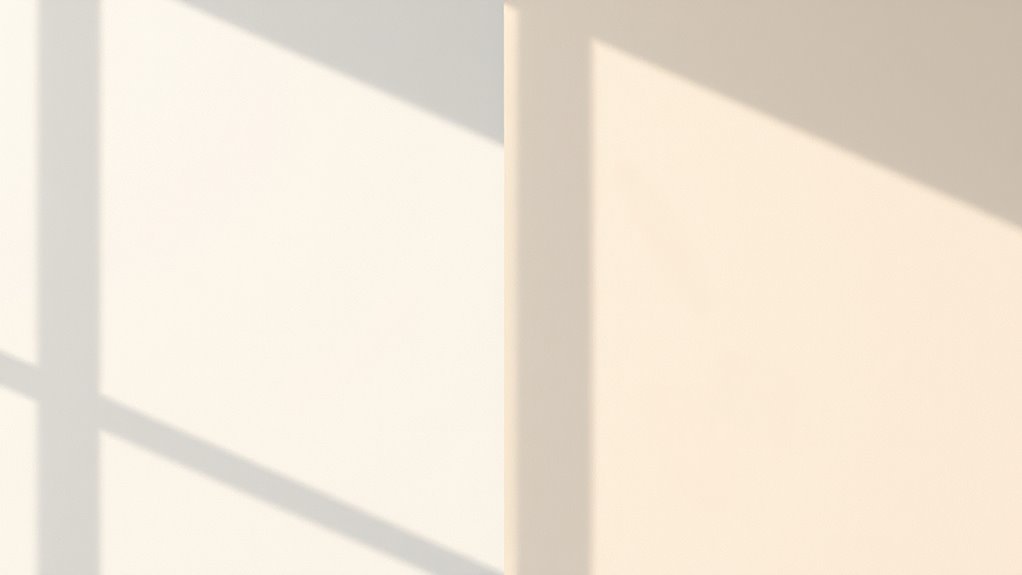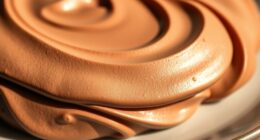When choosing paint finishes for easy cleaning, opt for satin, eggshell, or semi-gloss sheens, as they resist stains and are simple to wipe down, making them perfect for high-traffic or moisture-prone areas like kitchens and bathrooms. Avoid flat or matte finishes in these spaces since they show smudges and are harder to clean thoroughly. To guarantee long-lasting results, consider quality brands and proper surface prep—continue exploring for tips to make maintenance even easier.
Key Takeaways
- Choose satin or semi-gloss finishes for high-traffic or moisture-prone areas for easier cleaning and stain resistance.
- Avoid flat or matte finishes in busy spaces, as they are harder to clean and more prone to damage.
- Opt for eco-friendly, low-VOC paints to ensure durability and easier maintenance without harmful fumes.
- Proper surface preparation and high-quality brushes or rollers improve finish quality and ease of cleaning.
- Regular gentle cleaning with damp cloths helps maintain appearance and prevents buildup, prolonging the paint’s lifespan.
Understanding Different Paint Sheens

Understanding different paint sheens is essential when choosing a finish that’s both attractive and easy to clean. Paint sheen differences impact how a surface looks and how well it withstands cleaning. Flat or matte finishes hide imperfections but may be harder to wipe without damage. Eggshell offers a soft glow, balancing durability and ease of cleaning, making it popular for living rooms. Satin provides a smooth, velvety appearance that resists stains and is simple to maintain. Finish application techniques vary depending on the sheen you select; for example, higher-sheen paints typically require more careful brushing or rolling to avoid streaks. Knowing these differences helps you pick the right sheen for your space, ensuring your walls look good and stay clean with minimal effort. Additionally, selecting the appropriate paint finish can contribute to maximize space and organization by reducing the need for frequent repainting or touch-ups.
The Benefits of Satin and Eggshell Finishes

Satin and eggshell finishes make cleaning easier because they wipe down smoothly without damage. They also hide small imperfections on walls, giving your space a polished look. Plus, these finishes are ideal for high-traffic areas where durability matters. Additionally, choosing the right paint finish can help maintain your walls’ appearance over time and reduce the need for frequent touch-ups.
Easy Wipe Clean
Because they are easy to wipe clean, satin and eggshell finishes are perfect for busy areas or spaces prone to dirt and stains. Their smooth surface makes it simple to remove marks without damaging the paint. When choosing these finishes, consider your paint color palettes to match your decor. Additionally, look for eco-friendly finishes to reduce environmental impact. These finishes are durable and maintain their appearance over time, making maintenance easier. For optimal performance, selecting finishes with high durability can ensure long-lasting cleanliness and appearance. Use the table below to compare their features:
| Finish | Durability | Cleaning Ease | Ideal Spaces |
|---|---|---|---|
| Satin | High | Very easy | Kitchens, bathrooms |
| Eggshell | Moderate | Easy | Living rooms, hallways |
| Eco-friendly | Varies | Varies | Eco-conscious homes |
| Surface | Smooth | Wipe clean | High-traffic areas |
Conceals Surface Imperfections
If your goal is to hide surface imperfections, satin and eggshell finishes are excellent choices. Their subtle sheen helps with texture enhancement, making wall flaws less noticeable. They also excel at color concealment, creating a smooth, uniform appearance. Imagine:
- Light reflecting softly, reducing the visibility of bumps or dents.
- The finish blending uneven patches for a more consistent look.
- Shadows and imperfections fading into the background, thanks to their mid-level sheen.
- These finishes also support visual harmony by balancing durability with concealment, effectively masking flaws while maintaining an attractive appearance. You’ll find that satin and eggshell finishes effectively mask flaws, giving your walls a polished, flawless appearance while maintaining easy-to-clean qualities.
Suitable for High Traffic
When selecting a paint finish for high-traffic areas, durability is a key consideration, and satin and eggshell finishes deliver just that. These finishes are more resistant to scuffs, smudges, and cleaning, making them ideal for busy spaces like hallways and kitchens. Plus, they’re available in eco-friendly paints with low VOC content, so you can protect the environment and your indoor air quality. Satin and eggshell finishes also provide a soft sheen that hides surface imperfections, reducing the need for frequent touch-ups. Their durability ensures your walls stay looking fresh longer, even with frequent cleaning. Choosing these finishes helps create a space that’s not only resilient but also healthier and more environmentally conscious. Incorporating data-driven strategies into your paint selection process can help you assess the long-term benefits and maintenance needs of different finishes.
Why Semi-Gloss and Glossy Finishes Are Ideal for High-Traffic Areas

Semi-gloss and glossy finishes are excellent choices for high-traffic areas because they resist stains and are easier to clean than flat or matte surfaces. These finishes reflect light, highlighting imperfections but making maintenance simpler. When selecting these finishes, consider:
- Durability: They withstand frequent scrubbing, making them perfect for busy hallways or kitchens.
- Eco-friendly options: Many brands now offer low-VOC or water-based semi-gloss and glossy paints, reducing environmental impact.
- Cost considerations: While slightly more expensive upfront, their durability can save you money over time by reducing repainting needs.
Choosing semi-gloss or glossy finishes provides practicality and aesthetic appeal. Plus, they’re a smart investment, especially in spaces with high foot traffic where easy cleaning is essential.
Comparing Matte and Flat Finishes for Ease of Maintenance

Matte and flat finishes may look similar, but they differ in durability and how well they stand up to cleaning. You’ll find that some surfaces require gentler techniques to avoid damage, which affects maintenance routines. Considering how each finish maintains its appearance over time helps you choose the best option for your space. Understanding the cleaning requirements of each finish can help prolong their lifespan and appearance.
Durability and Wear Resistance
While matte and flat finishes may look similar, their durability and wear resistance can differ markedly, affecting how easy they are to maintain over time. Matte finishes tend to be softer, making them more prone to scratches and scuffs, which can hinder color matching after touch-ups. Flat finishes are slightly more resistant, holding up better against daily wear. Consider these factors:
- Flat finishes resist environmental impact better, reducing fading and maintaining appearance longer.
- Matte finishes are more delicate, requiring careful handling to avoid damage during cleaning.
- Both finishes may show wear differently, with flat finishes hiding imperfections better but being less durable overall.
Your choice influences maintenance, environmental impact, and how well the finish will stand up to wear over time.
Cleaning Techniques Required
When it comes to cleaning finishes, the ease of maintenance depends considerably on whether you have a matte or flat surface. Matte finishes typically require gentle cleaning methods, such as dusting or light wiping with a soft cloth, to avoid damage. Flat finishes are similar but can be more prone to showing smudges and stains, making quick, careful cleaning essential. Both finishes demand attention to paint color coordination; darker shades may hide dirt better, reducing cleaning frequency. From an environmental impact perspective, using minimal water and eco-friendly cleaning solutions helps protect both your walls and the planet. Additionally, understanding the types of toys that promote sensory development can guide you in choosing safer, more durable finishes for play areas. Overall, matte and flat paints are relatively easy to maintain if you follow appropriate cleaning techniques, which can prolong their appearance and reduce the need for frequent repainting.
Surface Appearance Maintenance
Choosing between matte and flat finishes largely depends on how easy you want your walls to stay looking clean. Matte finishes tend to hide imperfections and are forgiving with touch-ups, making color matching easier over time. Flat finishes, with their velvety texture, add depth but can be more challenging to clean without affecting appearance. To visualize:
- Matte finishes are ideal for areas where you want minimal maintenance and better concealment of dirt.
- Flat finishes offer a smooth surface that enhances texture options but may require more careful cleaning.
- Both finishes benefit from proper surface preparation to maintain their appearance and ease of touch-up, especially when matching colors later.
- When selecting a finish, consider the environmental conditions and how frequently cleaning will be needed, as this can influence durability and appearance over time.
Your choice impacts how well your walls maintain their look, so consider your cleaning needs and desired texture options carefully.
Choosing the Right Finish for Kitchens and Bathrooms

Selecting the right finish for your kitchen or bathroom is essential because these areas require surfaces that can withstand frequent cleaning and moisture. Satin or semi-gloss finishes are ideal, as they’re durable and easy to wipe down without showing smudges or water spots. When choosing a finish, consider color matching to ensure your space feels cohesive, especially if you plan to update fixtures or cabinetry later. Environmental considerations matter too; look for low-VOC or eco-friendly paints that reduce indoor pollutants and are safer for your household. These finishes resist mildew and moisture better than flat paints, making them perfect for high-humidity areas. By selecting a finish that balances durability, aesthetic appeal, and environmental impact, you’ll create a functional and attractive kitchen or bathroom space. Understanding industry trends helps in choosing finishes that remain popular and effective over time.
Tips for Applying and Maintaining Easy-to-Clean Paints

Proper application is key to guaranteeing your easy-to-clean paint performs well over time. Start by preparing surfaces thoroughly, smoothing out imperfections for even coverage. When applying, use high-quality brushes or rollers to prevent streaks and ensure durability. Regular maintenance is essential; follow these tips:
- Clean spills and smudges promptly with a damp cloth to maintain appearance.
- Use mild, environmentally friendly cleaners to reduce your environmental impact.
- Repaint when colors fade or chips appear, choosing shades rooted in positive color psychology to influence mood.
- Understanding paint finishes can help you select options that are not only easy to clean but also enhance the overall look and durability of your space.
Consistent upkeep preserves the paint’s integrity, making your space easier to clean and more inviting. Proper application and maintenance not only enhance the paint’s longevity but also support sustainable choices and thoughtful color choices that influence ambiance.
Common Mistakes to Avoid When Selecting Paint Finishes

While it’s tempting to focus solely on aesthetics, many people overlook common mistakes that can compromise their paint finish’s effectiveness. One mistake is poor color matching, which can result in mismatched shades that clash with your decor. To avoid this, test samples in your space before committing. Another mistake is neglecting proper paint ventilation during application; inadequate airflow can lead to uneven finishes and lingering fumes. Additionally, selecting a finish based only on appearance without considering durability can cause issues later. Remember, a glossy finish might look great but can highlight imperfections and be harder to clean, so choose wisely. Being mindful of these pitfalls guarantees your paint finish not only looks good but also performs well over time.
Best Brands and Products for Durable, Easy-to-Clean Paints

When choosing paints that are both durable and easy to clean, it’s essential to trust brands known for quality. Top brands include Benjamin Moore, Sherwin-Williams, and Behr, each offering products that stand up to repeated scrubbing. For example, Benjamin Moore’s Aura line features a smooth matte finish with a wide range of color palettes, perfect for any room. Sherwin-Williams’ Duration Home provides excellent stain resistance and eco-friendly options, reducing environmental impact. Behr’s Ultra Exterior offers durability for high-traffic areas and easy maintenance. These brands offer paints that balance durability with vibrant color options, ensuring your walls stay fresh longer. When selecting products, look for those with stain and scrub resistance for easy cleaning and eco-friendly formulations for a greener choice.
Enhancing Longevity With Proper Surface Preparation

Preparing your surfaces thoroughly before painting is key to guaranteeing your paint job lasts longer and resists damage. Use proper brush techniques to remove dust, grease, and loose paint, creating a smooth base. Sand uneven areas and fill holes to promote better adhesion. When selecting your paint, focus on color matching to ensure consistency, especially if you’re touching up or blending new with old paint. Proper surface prep prevents peeling, cracking, and staining, which can compromise easy-to-clean finishes. Take your time to clean and prime surfaces, paying attention to detail. This preparation not only enhances durability but also guarantees your chosen finish performs at its best over time. With careful surface prep, your paint will look better longer, making cleaning easier and maintaining its fresh appearance.
Frequently Asked Questions
How Do I Clean Paint Finishes Without Damaging the Surface?
To clean paint finishes without damage, you should use gentle cleaning techniques like soft cloths or sponges and mild soap or diluted cleaners. Avoid abrasive scrubbers that can scratch the surface. Always protect your surface by testing cleaning solutions in a small, hidden area first. Regular maintenance helps preserve the finish, and quick cleanup of spills prevents stains. Proper surface protection guarantees your painted surfaces stay fresh and damage-free longer.
Are There Environmentally Friendly Easy-To-Clean Paint Options?
You’re wondering if eco-friendly coatings offer easy-to-clean features. Many sustainable finishes now include environmentally friendly options that are both durable and simple to maintain. Look for paints labeled as low-VOC or non-toxic, which often come with easy-clean properties. These eco-friendly coatings are designed to be gentle on the environment while providing a surface that resists stains and can be cleaned with minimal effort, making them a smart choice for a sustainable, low-maintenance home.
Can I Switch Paint Finishes in the Middle of a Project?
Imagine switching gears on a road trip—you can do it, but it’s best to plan ahead. The same applies when changing paint finishes mid-project; paint finish compatibility and project timeline considerations matter. You can change finishes, but you might need to prep surfaces differently or wait for coats to dry. To avoid mishaps, consult your painter or manufacturer guidelines to guarantee a smooth shift without compromising your project’s quality.
What Are the Cost Differences Between Various Easy-To-Clean Paints?
When comparing costs of easy-to-clean paints, you’ll find that higher-quality finishes often cost more upfront but save you money long-term through durability. A flat or matte finish tends to be cheaper, but may require more frequent cleaning or touch-ups, increasing expenses. For budget considerations, semi-gloss or satin finishes offer a good balance of affordability and ease of cleaning, making them popular choices to keep your space looking fresh without overspending.
How Long Do Durable, Easy-To-Clean Paint Finishes Typically Last?
Think of durable, easy-to-clean paint finishes as your home’s armor, standing strong through daily battles. Typically, these finishes boast paint durability and finish longevity of about 5 to 10 years, depending on use and maintenance. High-quality options can last even longer, resisting stains and scrapes. Regular cleaning helps preserve their vibrancy and strength, ensuring your walls stay fresh and resilient, like a well-worn but cherished shield.
Conclusion
Choosing the right paint finish balances beauty with practicality. While matte or flat finishes offer a sophisticated look, they can be harder to clean—making them ideal for low-traffic areas. Conversely, semi-gloss or gloss finishes provide durability and easy maintenance, perfect for busy kitchens and bathrooms. By understanding these differences, you’ll make smarter choices, blending style with functionality and ensuring your spaces stay fresh and clean longer.









